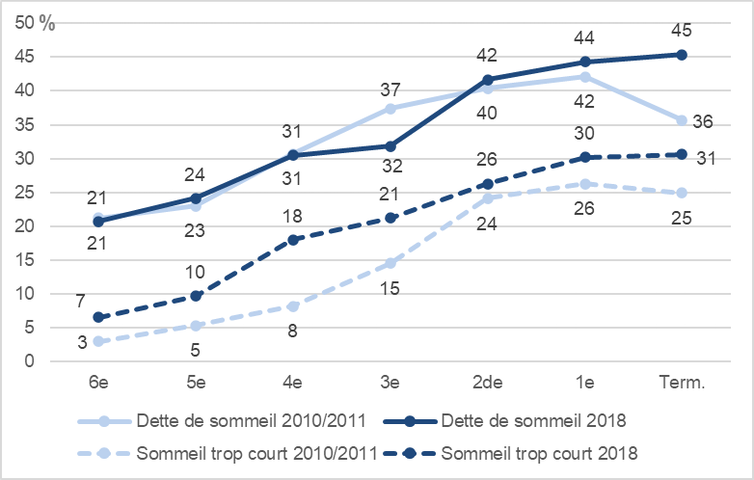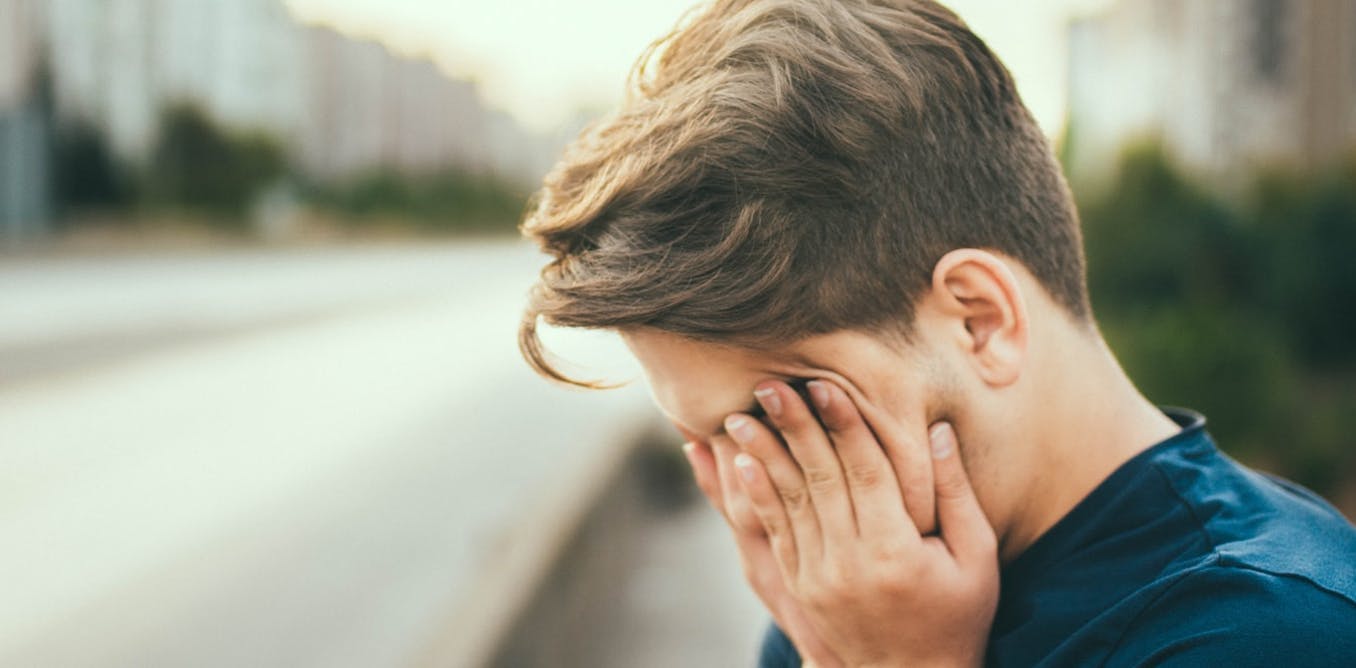In popular opinion, childhood or adolescence is synonymous with good, long-lasting, often interrupted, recovery sleep, accompanied by late mornings during weekends and school holidays.
In general, the quality of sleep is already excellent in young people: its duration is longer than in adults (10-12 hours in children and 8-10 hours in adolescents, compared to 7-8 hours in adults). Above all, their sleep is more stable: their nights are less interrupted by awakening, and richer in deep, recovering sleep.
However, in practice, things are a little different. Today, the quality of sleep for children and adolescents is no longer taken for granted, because many activities and demands constantly compete with and delay the desire to sleep. The use of more screens during the evening plays a particularly important role in this situation.
To find out where exactly young people stand in terms of bedtime, survey within It was conducted in 2018 on more than 20,000 students in middle and high schools in mainland France. This is what we can learn from its results.
The importance of sleep for health
Sleep is essential for physical and mental health. During sleep, many physiological rhythms are modified, and many hormones that contribute to tissue repair, immune defenses, or the body’s metabolic balance are simultaneously secreted: growth hormones, melatonin, cortisol, etc. Sleep is also necessary for memorization (particularly by phase paradoxical sleep), repairing the effects of stress and anxiety, or even maturation of the nervous system in children and adolescents.
The amount of sleep, like its quality, is essential to health. In adults, sleeping less than 6 hours every 24 hours is clearly associated with an increased risk of weight gain, obesity, type 2 diabetes, hypertension, cardiovascular disease, accidents, anxiety and depression. In children and adolescents, we talk about less than 7 hours of sleep per 24 hours. Then the types of risks to physical and mental health are the same as for adults.
Some sleep disturbances can also be associated with chronic health problems, respiratory (asthma or allergies), digestive or health problems (pain). This is, for example, a state of insomnia, which may be due to a difficult or noisy sleeping environment, or be an expression of psychological discomfort.
Screen use before bed is problematic for several reasons. On the other hand, blue light emitted by screens stimulates the circadian clock and delays the secretion of melatonin, the sleep hormone. On the other hand, social interaction late in the evening, and sometimes in the middle of the night, prevents relaxation and cognitive rest, which are essential to sleep. Besides social communication, for students, it’s also a lot of homework and needs to submit custom written college papers almost every day, which makes screen time necessary for research and writing.
However, tablets or smartphones can easily interfere with the lives of young people without any parental control, in bedrooms or beds, sometimes even late at night. It is also possible that successive periods of confinement in recent months have further instilled these habits in some students.
Increase sleep debt
French teenagers asked about their sleep for the first time On 2010 and 2011, as part of the investigations HBSC for college ESPAD for high school.
These studies have shown that an increasing percentage of middle school students sleep too little during class time and have sleep debt. 8 years ago, screen use in the evening was associated with sleep Shorter as well as difficulty sleeping. These sleep disturbances found in college students increase with age and have been found in high school students. Eight years later, the situation has not improved.
Investigation within In 2018, middle school students actually lost an average of 20 minutes of sleep each night: during the week, their sleep duration increased from 8.37 a.m. in 2010 to 8.16 a.m. in 2018. High school students, for their part, lost just 5 minutes during Same period: They slept an average of 7.19 hours in 2018.
EnCLASS 2018, OFDT Exploit, EHESPAnd the Author introduced قدم
between grade 6e and 3eStudents lose a quarter of an hour of sleep annually, with average times dropping from 8:50 a.m. to 7:45 a.m., which is more than an hour less sleep per night at the end of college. If the transition from middle school to high school results in a new loss of sleep of an average of 19 minutes, that duration hardly changes, decreasing by only 7 minutes between the second and last.
Note that senior year boys have the shortest average bedtime on school days: 7:05 a.m. This time is close to the sleep duration of adults on working days in France, which is 6h58 according to data from Latest health scale.
At 8 years, the percentage of middle school students who slept less than 7 hours per 24 hours on school days, i.e. the threshold below which the risk of comorbidities was reduced, decreased from 7.8% to 13% and the proportion of high school students from 25, 1% to 29%.

EnCLASS 2018, OFDT Exploit, EHESPAnd the Author introduced قدم
Today, one in four college students (26.7%) and four in ten high school students (43.7%) can be considered “sleep debt” (because sleeping for at least 120 minutes in the morning without a class is more than those with a class The next day). In college, this debt is more concerning for girls than for boys (31.4% vs. 22.2%). This difference is also present in high school, albeit to a lesser degree (46.5% vs. 40.8%).
Tiredness in the morning and sleep duration
Fatigue is one of the first consequences of not getting enough sleep, especially in the morning. In general, half of high school students get tired at least one day a week. Even more, 3 in 10 middle school students (30.6%) and 4 in 10 high school students (41.4%) feel tired almost every day of class when they wake up in the morning.
Apparently, students who sleep less than 7 hours a night and who have sleep debt are more fatigued than others.
It is also estimated that in children and adolescents sleeping for more than 30 minutes is insomnia. However, according to their statements, about a third of high school students are affected by insomnia during sleep. Here again, these difficulties are more common in students who are sleep debt or who have a lack of sleep.
Ultra-digital evenings
Screen use during the evening is a common activity among a large portion of the students, regardless of their age. However, this survey reveals that these practices are more frequent among teens whose sleep duration is very short, and especially among those with sleep debt.
About 4 in 10 college students say they surf the internet, call or watch TV before bed. Reading in the evening was mentioned by just over a third of college students, and those with sleep debt are also those least likely to read at night (16%).
In high school, 6 in 10 teens say they go online at night, listen to music, or even do both. Two-thirds of them communicate by phone, and roughly one in every two hours watches a TV, series, or movie. Note that among high school students with sleep debt, 72.9% call and 72.2% surf the Internet (while only 15.2% say they read). Among the short sleepers, two-thirds also engage in these activities in the evening.
Thus, sleep among French college and high school students keeps away from them year after year Misuse of digital mobile technologies. We know that in order to sleep well, it is necessary to set aside a period to prepare for bed. It’s about stopping any highly motivating activity, especially digital uses.
A balance must therefore be found between the social and educational role of young people’s access to new technologies and awareness of their harmful health risks. It is a matter of promoting a rational use of them, without demonizing them, but without minimizing the risks of their abuse.
We see that falling asleep seems more difficult for teenagers. This situation can raise concerns about consequences in terms of attention, learning, comorbidity risks, and incidental risks. It seems important to us Inform children and parents, emphasizing the importance of adequate quality health and well-being and adequate sleep, especially among young people.
For more : “The Sleep of Middle and High School Students in 2018. Results of the National Survey of Middle and High School Adolescents on Health and Materials (EnCLASS) 2018”, Ren, EHESP, 2020.

“Subtly charming problem solver. Extreme tv enthusiast. Web scholar. Evil beer expert. Music nerd. Food junkie.”

